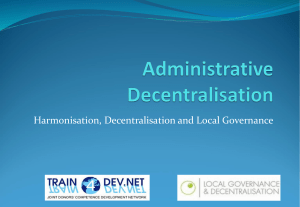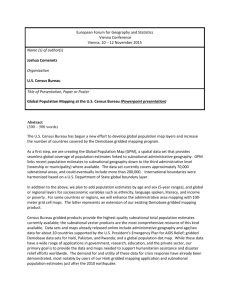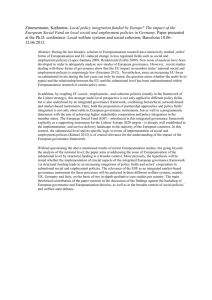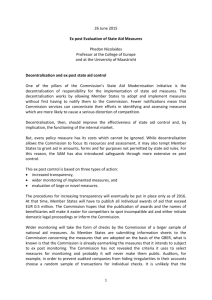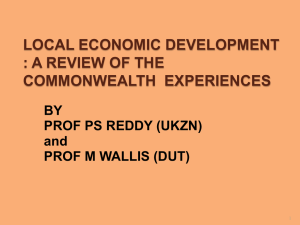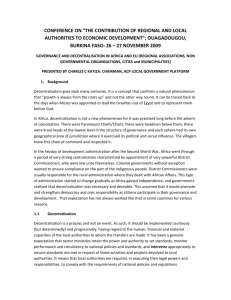Working in decentralised service systems: Short report on
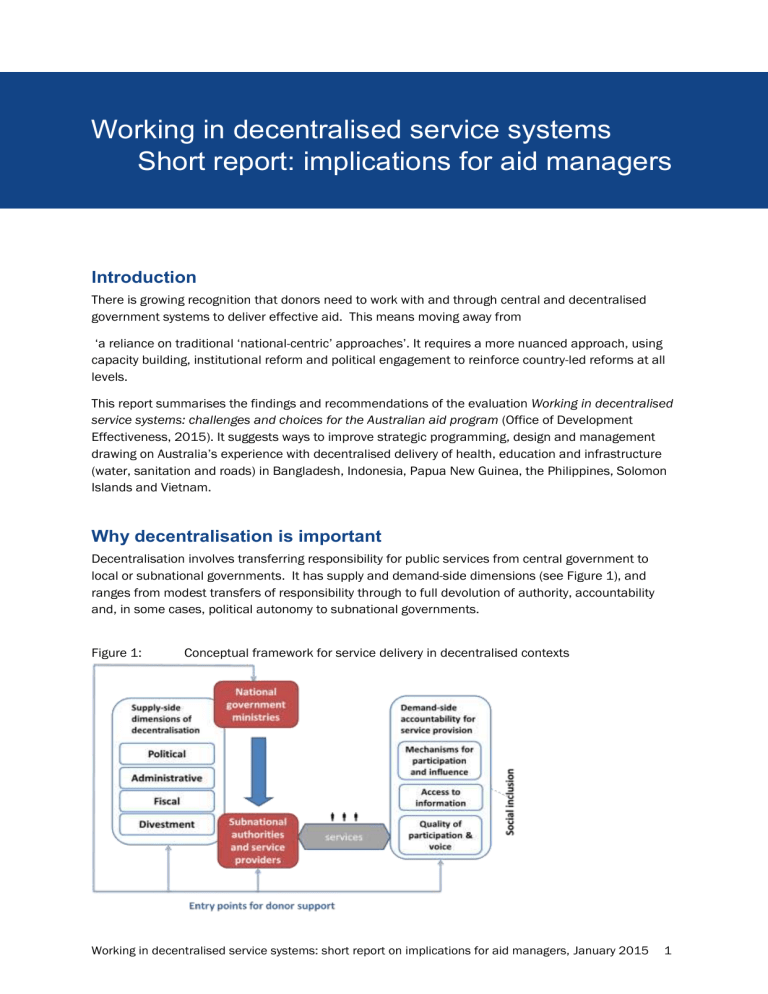
Working in decentralised service systems
Short report: implications for aid managers
Introduction
There is growing recognition that donors need to work with and through central and decentralised government systems to deliver effective aid. This means moving away from
‘a reliance on traditional ‘national-centric’ approaches’. It requires a more nuanced approach, using capacity building, institutional reform and political engagement to reinforce country-led reforms at all levels.
This report summarises the findings and recommendations of the evaluation Working in decentralised service systems: challenges and choices for the Australian aid program (Office of Development
Effectiveness, 2015). It suggests ways to improve strategic programming, design and management drawing on Australia’s experience with decentralised delivery of health, education and infrastructure
(water, sanitation and roads) in Bangladesh, Indonesia, Papua New Guinea, the Philippines, Solomon
Islands and Vietnam.
Why decentralisation is important
Decentralisation involves transferring responsibility for public services from central government to local or subnational governments. It has supply and demand-side dimensions (see Figure 1), and ranges from modest transfers of responsibility through to full devolution of authority, accountability and, in some cases, political autonomy to subnational governments.
Figure 1: Conceptual framework for service delivery in decentralised contexts
Working in decentralised service systems: short report on implications for aid managers, January 2015 1
Public services have been decentralised in most countries where Australia provides aid. In 2014–15, almost half the Australian aid budget will be spent on education (23 per cent), health (16 per cent) and infrastructure (ten per cent). Much of this will be delivered through decentralised service systems.
In the right context, decentralisation can make service delivery more efficient and effective, but it may have negative effects if local participation and accountability are constrained. Working appropriately in decentralised contexts is critical to the effectiveness of Australian aid.
Evaluation findings
Australian aid has recognised and responded to the difficulties of improving services in decentralised systems. Challenges include dealing with numerous counterparts, working in low-capacity subnational settings, managing tensions, navigating ambiguous roles, and making do with limited service delivery resources.
The evaluation found the quality of analysis of decentralisation contexts was adequate at the macrolevel, but there was insufficient attention to particular subnational constraints, opportunities and management issues. Most country strategies addressed decentralisation soundly (the Philippines was strongest), but thematic strategies were inadequate. The evaluation identified a one-dimensional approach to defining ‘partner governments’ in aid management guidance as a problem. It assessed the current guidance was unhelpful for prompting aid managers to analyse competing interests and weigh up how best to engage with government at different levels.
Policy alignment at both national and subnational levels of government was judged mostly appropriate. However, there were some instances (for example, in the education sector in Papua New
Guinea) where Australia’s aid contributions did not help to clarify education priorities and responsibilities between national and subnational authorities. There was a risk that selected service delivery approaches (for example, providing kit school buildings in PNG through a contractor) might undermine long-term plans to improve government accountability.
The evaluation found the balance of strategy and policy engagement—between national and subnational levels, central and sector ministries, and elected and local leaders—was generally not appropriate. Programs tended to focus in one way or another, rather than systematically assess the most constructive way to engage for the best development outcomes while managing the risks (e.g. engaging at one level may create disincentives for accountability at another). Sector programs often focussed on the supply of services at the expense of building demand (i.e. enabling citizens to hold government and service providers to account for service quality and sustainability). Programs that did address both supply and demand delivered good results (see, for example, Box 2 below).
The evaluation found that Australian aid has had only ‘variable success’ sustaining service delivery outcomes in decentralised contexts. Evidence from the evaluation suggests it may be too early to say whether efforts to promote strong national and subnational ownership will be sustainable. Under the
Australia–Indonesia Partnership for Maternal and Neonatal Health, there was evidence of local buy-in and support, with local parliaments agreeing to finance incentive payments for medical personnel and transport to health centres. In the Philippines, Strengthening the Implementation of Basic Education in
Selected Provinces in the Visayas (STRIVE) worked through education structures at central, regional and divisional levels and ensured program-related functions (such as monitoring) were built into the normal roles of permanent staff. However, in both cases there were concerns about sustainability, related to poorly-developed systems, problems retaining staff and weak leadership. Potential lack of ownership and unspecified long-term responsibility for maintenance were identified as major risks to sustainable delivery of school infrastructure in PNG and provincial roads in the Philippines.
2
Working in decentralised service systems: short report on implications for aid managers, January 2015
Australian assistance was judged sufficient in how it approached equity of service delivery in decentralised contexts considering poverty and socio-economic needs. However, few initiatives paid sufficient attention to other dimensions, including promoting gender equality, empowering women and addressing marginalised groups’ needs and interests. The evaluation considered this was partly due to limited attention to demand-side issues (as noted above). A notable exception was the PNG program, which ensured women were on decision-making boards for health and education policies and programs.
The evaluation found a gradual improvement in the coherence of strategies and approaches to decentralisation between country and sector interventions, national and subnational locations, and between various aid management guidelines and templates. The Philippines was considered the best example of a coherent country-specific approach, as explained in Box 3 below.
Decentralisation challenges and aid management implications
Australia’s experience with decentralisation suggests several strategies that may improve the effectiveness of aid in decentralised contexts, as outlined in Box 1.
Box 1 Useful strategies for working in decentralized service delivery systems
Useful strategies for working at national-level include:
› assisting different parts of partner governments to align their policies and programs through the provision of coordinated technical advice, funding and other support
› promoting good governance in all aid investment plans at country level.
Useful strategies for working at subnational-level are:
› ensuring the views and preferences of subnational authorities are taken into account during design
› using carefully designed incentives to improve performance
› harnessing the support of local leadership, whilst recognising the risks of political changes
› placing aid program staff at subnational levels of government
› building financial management capacity at the subnational level where there is high fiduciary risk.
The evaluation suggests three priorities for improving how Australian aid managers address decentralisation when deciding future investments:
1.
work to improve service systems rather than deliver services where this is feasible
2.
choose implementation partners carefully, and consider unintended effects
3.
work towards consistent and coordinated investments, policies and systems.
The following sections synthesise the aid management implications of the evaluation’s findings related to these priorities.
Working in decentralised service systems: short report on implications for aid managers, January 2015
3
1. Work to improve service systems rather than deliver services where feasible
The Australian aid program is more likely to achieve sustainable improvements in services delivery if it works to improve service delivery systems rather than directly support the delivery of health, education, infrastructure or other services. This is particularly the case where there is a viable or functioning delivery system in place. In fragile and conflict affected contexts there may not be viable service delivery systems and alternative, more direct approaches may be required. In such situations it is still important to identify local partners and avoid setting up parallel service delivery mechanisms.
The aid program cannot work with every component of the service system, but managers can ensure that Australian aid reinforces sustainable and accountable service delivery at all levels. Strong involvement of subnational authorities is more likely to lead to sustained service delivery. However, there are risks and costs in working through government where high poverty levels coexist with corrupt and/or poorly performing government systems. Supporting local communities to engage with local levels of government is important for building government accountability, and ensuring that community preferences are factored into service design and delivery.
There are many choices about where to invest aid to improve services. It is important to conduct sound contextual analysis, including political factors and how service delivery works at the national and subnational levels. Knowledge of local staff with an understanding of local norms, culture and politics can usefully inform these decisions. Decentralised service systems are usually complex, varied and changeable; therefore analysis needs to be timely and thorough.
2. Choose implementation partners carefully, and consider unintended effects
Partner government systems involve competing interests and potential conflicts over power and authority. Aid managers should not focus engagement solely at the national level, or with selected partners or stakeholders, without careful consideration of the risks and benefits of dealing with each.
It is important to be aware that decentralisation is not a one way process, and functional responsibilities are liable to shift between national and subnational levels over time.
National level government bodies are indispensable partners as they often control the policies and systems that can undermine or improve service delivery. This requires Australia to engage with central as well as sector ministries. To increase the potential for effectiveness requires senior aid program staff to keep abreast of service delivery reforms and policies. They also need to dedicate time to policy dialogue at national and other levels of government as required to build ownership of long-term service delivery changes.
An important strategy is to consider changing the incentives that shape national and subnational government performance. The Australian-funded Hibah program in Indonesia, featured in Box 2 below, shows how Australia worked successfully with the Government of Indonesia and civil society on several levels to increase the demand for, and supply of, water and sanitation to poor urban areas.
A country’s service system may include a range of service providers: private sector, community groups, churches, non-governmental organisations or public agencies. Local leaders and communities—as service users, local citizens and representatives of local citizens—can all be effective partners to improve service delivery systems.
The choice of implementing partner and form of aid may impact on national decentralisation processes and priorities, especially if Australian aid is a large proportion of resources in a sector. For example, sector-wide approaches and sector budget support have been criticised for recentralising some functions. Using private sector contractors to work around weak subnational systems, or bypassing one level of government to work with another, may undermine long-term national reform
4
Working in decentralised service systems: short report on implications for aid managers, January 2015
plans. It is important for program managers to consider the full range of potential service delivery effects (i.e. positive and negative, intended and unintended, short-term and long-term) when designing programs and selecting partners and delivery modalities.
Box 2 How decentralisation can make a difference: water and sanitation in
Indonesia
The Australian-funded Water and Sanitation ‘Hibah’ or grant program in Indonesia focuses on increasing water supply and sanitation connections for poor urban households. The initiative is strengthening the water and sanitation service system by:
› improving and expanding service delivery
› increasing local government investment
› improving sustainability through sector reform and improved local-level governance.
The Hibah program has partners across national and subnational levels. National government departments are strongly involved, including Ministry of Public Works, Ministry of Finance and Ministry of Planning. The Hibah program is aligned with Indonesia’s national priorities to meet the Millennium
Development Goals and to address key decentralisation challenges.
The Hibah program addresses the reluctance of district governments at subnational level to invest in water supply and sanitation which has resulted in a loss of service delivery. The initiative uses an output-based approach as an incentive for local governments to invest more in local utilities for which they are responsible. Districts install and pay for water and sanitation connections first, and are then reimbursed by the program. Through effective promotion strategies including working with media, the
Hibah program has successfully struck a balanced engagement with national and provincial political leaders and local administration. The program has also been successful in developing incentives for local government which sees there are votes in being involved in the program.
An initial phase in 2009–11 ($20 million) reached 77 000 households with water and 5000 with sewerage, working with 35 different local governments. A second phase in 2011–14 ($95 million) aims to reach a further 250 000 households with water and 9000 with sewerage, working with 95 local governments.
Whilst there have been government investments at the national level, in the form of personnel and funding to administer the Hibah program, and investment from local water supply authorities and governments, the sustainability of outcomes is yet to be determined. It is not clear whether the Hibah program has provided sufficient capacity-building support at the local subnational level to ensure the ongoing delivery of services.
Considerations in determining the most appropriate partners are:
-
Which parts of the government need to be engaged - national, subnational, central and sector agencies for effective investment?
-
How accountable and transparent are the subnational authorities and service providers to the communities they serve?
-
What other nongovernment partners need to be engaged – communities, civil society organisations, local leaders, private sector- to ensure community service needs and preferences are addressed and government accountability strengthened?
-
Where should the program be located at subnational level taking into consideration the- potential for addressing localised needs, fiduciary risk, influencing policy, and scaling up and extending the investment?
5
Working in decentralised service systems: short report on implications for aid managers, January 2015
-
Which aid modality and lead delivery partner(s) are best suited to manage and implement the program?
-
How can flexibility be built into the program design to adjust to the changeable dynamics of a decentralised service system?
More detailed guidance on choosing partners is provided in the ‘ Decentralisation analysis for investment decisions: practice note ’.
3. Work towards consistent and coordinated investments, policies and systems
Greater coordination between investments working through and with government systems reinforces the effectiveness of:
sector investments that directly support service delivery in health, education, infrastructure or other sectors
governance investments that address systemic governance issues or work to improve country decentralisation processes more specifically.
Responsibility for this coordination lies with both the governance and sectoral teams. Stronger links between sector and governance investments can lead to more effective programming, because governance investments can be used to target political and administrative constraints to improving service delivery in particular sectors.
Box 3 The Philippines program: a good example of consistent and coordinated approaches to decentralisation
The Philippines Country Strategy has promoted strong links between its governance and sector programs :
› governance programs were explicitly related to service delivery and sector programs
› governance programming had a clear crosscutting objective to support sector programs
› the Country Strategy was flexible and responsive to changes in national government and decentralisation reforms and took an iterative approach to programming.
The evaluation suggests the following actions may enable more coordinated and consistent approaches to decentralisation throughout DFAT, and between and within aid management teams working in decentralised contexts:
-
Prioritise governance in Australian aid investment plans to support service delivery and sector programming (see Box 3).
-
Sequence aid investment plans, sector investment plans and initiative designs in ways that reinforce decentralisation and service delivery improvement priorities.
Balance higher-level Australian country strategy objectives with flexibility and responsiveness to national and subnational reform opportunities.
-
Understand the interests and perspectives of different levels of government, which may not have strong functional relationships.
-
Make better use of guidance, analysis and in-country knowledge on decentralisation.
-
Regularly meet, jointly plan and share information and learning between programs, technical advisers and managing contractors working in the same subnational areas.
-
Place staff at local level to play a coordinating and advisory role to support Australia’s subnational aid programming (see Box 4).
Working in decentralised service systems: short report on implications for aid managers, January 2015
6
Box 4 Use of locally based staff to support coordination and coherence
The Australian aid program has placed staff at subnational level in the provinces of Papua New
Guinea for almost 10 years in an effort to support the decentralisation process, represent the aid program and inform Australian aid programming. These positions have helped to:
› Develop understanding of the political economy, governance arrangements and mechanics of service delivery under the decentralised system.
› Coordinate locally implemented Australian assistance, ensure stakeholder awareness and promote understanding and ownership.
› Strengthen provincial administrative processes; budgeting, spending, human resource and performance management.
› Monitor informally ‘on the ground’ and advise sector and governance program staff on improving local implementation.
› Provide ongoing needs analyses of provincial, district and local government requirements.
› Promote cross-cutting issues such as gender and HIV/AIDS prevention at subnational level.
Aid managers need to consider what decentralisation means for effective aid in their particular country context. Table 1 summarises challenges identified during the evaluation, and potential aid management implications.
Table 1 Summary of challenges and implications for improving services in decentralised systems
Challenge presented by decentralisation Implications for the Australian aid program
Responsibilities may be distributed across different national and subnational government and authorities.
Program managers need to decide how to align with priorities at each level. This may require difficult tradeoffs and may challenge long-standing relationships.
Roles and responsibilities across tiers of government often unclear.
Up-to-date information needed to inform decisions, and for assessing and managing risk.
Decentralisation usually happens unevenly, due to stronger and weaker jurisdictions.
Targeting areas of higher poverty brings with it the risks of engaging with flawed and weak systems.
Decentralisation may not lead to greater local accountability for services.
Consider most effective balance between supporting supply and strengthening demand.
Sustainability may be constrained by limited capacity at subnational level, including staff turnover.
Need to provide assistance over longer timeframes, and select flexible aid modalities to meet changing needs.
Decentralisation may be resisted by those whose power and authority it challenges.
Governance reforms may be contradictory.
Staff should be alert to tensions and risks of decentralisation. Some sector reforms (e.g. sectorwide approaches) may recentralise functions.
Working in decentralised service systems: short report on implications for aid managers, January 2015
7
Evaluation recommendations
The evaluation made four recommendations for changes within DFAT:
Recommendation 1
DFAT should continue to trial new programming strategies in decentralised contexts, using the practice notes developed in this evaluation, together with mandatory program management requirements (value for money, risk, monitoring).
Recommendation 2
Program managers should consistently address decentralisation in designing, monitoring and evaluating aid in decentralised contexts. Checklists, expert advice (e.g. on draft strategies, designs and evaluations), and improved access to country-specific information and analysis, may help to improve how aid managers think about and respond to decentralisation.
Recommendation 3
DFAT should carefully consider how decentralisation and subnational roles are addressed when updating key strategy and guidance documents, and referring staff to relevant resources (including the practice notes developed in this evaluation). In particular, DFAT should expand the ‘working in partner systems’ guidance and assessment tools beyond public financial management and risk management concerns, to include broader public sector capabilities such as human resources, monitoring and evaluation and sector-specific technical expertise.
Recommendation 4
DFAT should foster specific governance capability in areas related to decentralisation and subnational levels of government, including through: i incentives and mechanisms to enable collaboration between governance and service delivery sector managers ii skills, knowledge and resources for governance staff to support sector staff iii opportunities for sector staff to improve their knowledge of governance and decentralisation, including formal training opportunities and resources for on-the-job learning.
DFAT agrees, or agrees in principle, with all four recommendations of the evaluation. For the full evaluation and DFAT’s management response, please see http://www.dfat.gov.au/ode
Working in decentralised service systems: short report on implications for aid managers, January 2015
8
